Newpaper Article of the Conolly Family From Dunstable Mass That Was Killed in 1967
Reverend Samuel Parris was the minister at Salem Village during the Salem Witch Trials of 1692.
Samuel Parris was born in London, England in 1653. In the late 1650s, his father, Thomas Parris, moved his unabridged family unit to a saccharide plantation that he had purchased in Barbados.
Samuel Parris' Early on Life:
In 1673, Samuel Parris was attending Harvard in Cambridge, Massachusetts when his begetter died. He left Harvard without graduating and returned to Barbados and take accuse of his begetter's manor. He then became a saccharide merchant in Bridgetown only was unsuccessful in the business organization.
In 1680, Parris moved to Boston, the uppercase of the Massachusetts Bay Colony, with his 2 slaves, Tituba and John Indian. He married Elizabeth Elridge that year and the couple had 3 children: Thomas, Betty and Susannah. Parris once once again tried to find work as a merchant but then decided to change careers and began preparation to become a minister.
In 1686, Samuel Parris began serving every bit a guest minister and interim pastor for several Boston churches. In 1688, Parris entered negotiations to become the new minister in Salem Hamlet. Parris accepted the position and became the official minister in July of 1689.
At the time, Salem was suffering from abiding conflicts and feuds. The previous three ministers that served in Salem had frequently constitute themselves caught in the middle of the conflict. The parishioners often refused to pay the minister's salary, provide firewood for the parsonage, keep upwardly renovations on the church building and etc.
As a consequence, Salem went through three ministers in 16 years, one of which was Rev. George Burroughs who was after accused of witchcraft during the Salem Witch Trials in 1692.
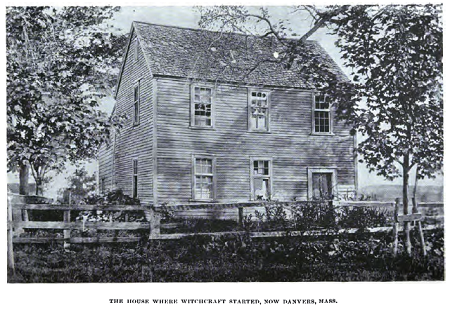
"The House Where Witchcraft Started," photo of the Salem Village Parsonage, home of Samuel Parris, Danvers, Mass, published in Witchcraft Illustrated past Henrietta D. Kimball, circa 1892. This house is actually just an addition that was added to the parsonage business firm in 1734. The original parsonage house was torn down in 1784 and this addition was and so moved to Sylvan Street in Danvers.
When Parris began his new position, he apace found himself in the eye of these same Salem feuds and, according to the volume The New England Soul, he didn't handle it well:
"Parris had not enjoyed a moment's peace since the commencement of his ministry building in 1689, when he found himself caught between warring factions in Salem Town and Salem Hamlet. Instead of confining and channeling social fears and tensions into revival and covenant renewal equally his colleagues were seeking to do, Parris inflamed local rivalries by declaring that 'if ever in that location were witches, Men and Women in covenant with the Devil, here are multitudes in New-England.' By March 1692, he was convinced that witches had infiltrated the churches, including his own Salem congregation. In a sermon on Judas Iscariot he declared that 'every bit in our text [John 6:10] there was one [devil] among the 12 [disciples]…so in our churches God knows how many Devils at that place are.' Such preaching offered a powerful and dangerous release for social and political tensions that had been brewing throughout the previous decades. It encouraged the villagers to purge their feelings of frustration and guilt by locating and destroying 'witches' in their midst. In many cases these witches were individuals who had run afoul of Parris and his primal clan of supporters, the Putnam family."
Samuel Parris & the Salem Witch Trials:
Many historians agree that Samuel Parris played a pivotal role in the Salem Witch Trials and some fifty-fifty consider him i of the primary causes of the trials, according to the book The Account of the Life of Samuel Parris:
"We have been thus detail in relation to the settlement of Mr. Parris at Salem Village, it being one of the causes, which led to the most biting parochial quarrel, that ever existed in New-England, and in the stance of some persons, was the primary or chief cause of that world-wide famous delusion, the Salem Witchcraft."
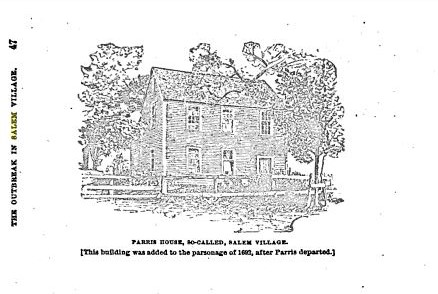
"Parris House, So Chosen, Salem Village," illustration published in Witchcraft in Salem Village in 1692; Winfield South. Nevins; circa 1916
The Salem Witch Trials began in Salem Hamlet the winter of 1692 when the afflicted girls, which included Parris's girl, Betty Parris, and his niece Abigail Williams, began displaying strange beliefs such as suffering fits, complaining of being pinched by invisible forces and etc.
A local doctor was called and when he couldn't determine the cause of the fits, he declared they were bewitched, co-ordinate to Samuel Page Fowler in his book Account of the Life and Character of Rev. Samuel Parris of Salem Village:
"Mr. Parris appears to have been much astonished, when the physicians informed him, that his daughter and niece were, no doubt, under an evil mitt. There is show that Mr. Parris endeavored to continue the opinion of the physicians a secret, at least, till he could decide what form to pursue. At this time, Mary Sibley, a member of his church, gave directions to John Indian how to find out, who bugged Betsy Parris and Nabby Williams. This was done without the cognition of Parris. The ways used to brand the discovery, was to brand a cake of rye meal, with the urine of the children, and bake it in the ashes, and requite information technology to a domestic dog to eat. Similar disgusting practices appear to have been used to discover and kill witches, during the whole period of the delusion."
A few days afterwards the witch cake incident, the girls named three women they believed were bewitching them: Sarah Skilful, Sarah Osbourne and Tituba.
After Tituba was arrested on March one, she made a shocking confession that she was indeed a witch and warned that there were other witches in Salem. This confession sparked a mass hysteria and started a massive witch chase in the colony.
Many historians believe that the Putnam family, especially Thomas Putnam, took advantage of this mass hysteria by accusing people they disapproved of or wanted revenge against. I theory suggest Thomas Putnam solicited the help of Samuel Parris, amongst many others, in his crusade.
Nevertheless, according to Fowler, there is no evidence that Parris was fifty-fifty involved in the accusations:
"It has been said that Parris had a rival in Rev. George Burroughs, who had friends in Salem Village, desirous of his settlement; and that was a sufficient reason why Parris should appear at the courts against him. We have never seen any proof of this rivalship between these clergymen. It is hard now to define the cause of the arrest of Burroughs who was preaching at Wells, at the time, in his pulpit. The girl who accused him of bewitching her, was Mercy Lewis, who was and then living with Thomas Putnam. She formerly lived with Burroughs, when he preached at the Village; and, upon one or more occasions, he whipped her severely. This we suspect was the cause of her crying out confronting Mr. Burroughs. It has been said that Rebecca Nurse was an object of special hatred to Parris; just this nosotros have failed to discover….We doubtable, from an examination of the charges brought confronting her at the courts, that she had several times severely rebuked the accusing girls for their folly and wickedness, when coming together in their circles. In this way, she probably incurred the displeasure of Ann Putnam and her female parent – her principal accusers."
The only thing Parris seemed to do for certain was suggest during his sermons that witches were present in Salem. On March 27, Parris informed his congregation about the witch cake incident with Tituba and expressed feared that it may have raised the Devil in Salem, according to the church building records:
"27. March. Sab. 1692. Sacrament twenty-four hour period.
Later the common auditory was dismissed, & before the Church'southward communion at the Lords Table, the following testimony confronting the mistake of our sister Mary Sibley, who had given management to my Indian man in an, unwarrantable way to find out Witches, was read by the pastor. It is altogether undeniable that our great & Blessed God, for wise & holy ends hath suffered many persons, in several families, of this niggling hamlet, to be grievously vexed, & tortured in body, & to exist securely tempted, to the endangering of the devastation of their souls; & all these amazing feats (well known to many of us) to be done by witchcraft, & diabolical operations. It is also well known that when these calamities, starting time began, which was in my ain family, the illness was several weeks earlier such hellish operations, as witchcraft was suspected. Nay it never broke forth to any considerable light, until Diabolical ways was used by the making of a cake past my Indian man, who had his management from this our sister Mary Sibley : Since which apparitions have been plenty, & exceeding much mischief hath followed. But by this ways (it seems) the Devil hath been raised amongst us, & his Rage is vehement & terrible, & when he shall be silenced the Lord only knows. But now that this our sister should exist instrumental to such distress, is a swell grief to myself, and our godly honoured & reverend neighbours, who have had the noesis of it. Still, I do truly promise, & believe, that this our sister doth truly fear the Lord, & am well satisfied from her, that what she did, she did information technology ignorantly, from what she had heard of this nature from other ignorant, or worse persons. Yet we are in duty bound, to protestation against such actions, as being indeed a going to the Devil, for help confronting Devil, we having no such directions from nature, or Gods discussion, it must therefore exist, & is, deemed by godly protestants, who write or speak of such matters equally diabolical, & therefore calls this our sis to deep humiliation for what she has done, & all of usa to be watchful against Satans wiles & devices. Therefore, as we in duty, equally a Church building of Christ are deeply bound, to protest confronting information technology, equally most directly contrary to the gospel, still in equally much as this our sister did it in ignorance as she professeth, & we believe, nosotros can continue her in our holy Fellowship, upon her serious promise of hereafter meliorate advisedness and circumspection, & acknowledging that she is indeed sorrowfull for her rashness herein. Brethren, If this be your mind that this iniquity should exist thus built-in witness against, manifest it by your usual signe of lifting up your hands. The brethren voted mostly, or universally: None made any exceptions. Sister Sibley, If you are convinced that you lot herein did sinfully, & are sorry for it: Let us hear it from your own mouth. She did manifest to satisfaction her mistake & grief for it. Brethren. If herein you take received satisfaction, testify it past lifting up of your hands. A general vote passed: no exception fabricated. Note. 25. March. 1691-2 I discoursed said sis in my study about her chiliad fault abovesaid, & likewise and then read to her what I had written as in a higher place to read to the Church, & said sister Sibley assented to the same with tears & sorrowful confessions."
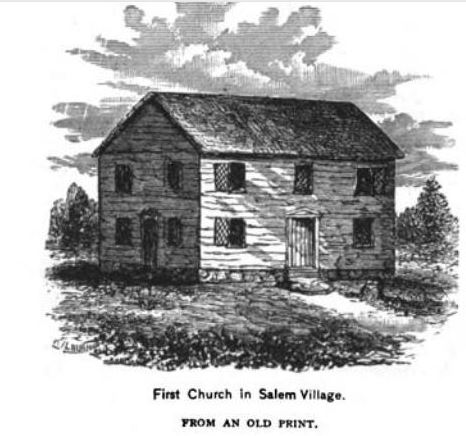
Showtime Church in Salem Village, illustration published in the New England Magazine Book five, 1892
Parris also gave a sermon that day, which was titled "Christ Knows How Many Devils There Are" that was plainly written considering, equally Parris states in the sermon: "dreadful witchcraft broke out here a few weeks past."
Inside the first few lines of the sermon Parris quoted John 6:seventy when he stated: "Have non I chosen you twelve, ane of yous is the Devil."
Equally he spoke nearly Judas, hypocrites and wicked angels, Parris repeatedly quoted the line "One of you is a Devil" and suggested that God knew who the Devil was among them. Parris also suggested during the sermon that the devil could be a beau church-goer when he stated:
"Let none and so build their hopes of salvation merely upon this: that they are church members. This you and I may be, and all the same devils for all that (Matth: viii:11-12 – "Many shall come from the eastward and west, and shall sit down down, etc. And all the same we may pass here, a truthful divergence shall be made shortly.)"
Shortly after, Parris invited neighboring ministers to his house to give advice on what they should do about the presence of witches in Salem. The ministers just advised Parris to "sit down yet and look on the Providence of God to encounter what time might discover." Two or three more private fasts were held at Parris firm as Parris continued to wait and see what would happen. According to Fowler:
"It is evident from the account given by Rev. John Hale, who was an centre witness to many of the transactions at Salem village, and one of the minsters called for consultation, that Mr. Parris proceeded with caution at the commencement of the troubles, and was anxious to seek council and communication. He likewise wished to inform himself on the subject of witchcraft, and for that purpose received as a loan from Dea. Robert Sanderson, of Boston, a re-create of Perkins' works, which treated upon the subject. We are among those who believe Mr. Parris was honest in his conventionalities in witchcraft, and that he was not moved in his affair past personal malice, or the desire to promote the cause of religion in his Parish, as has been supposed by the author of the History of Danvers. We have not as yet, institute a particle of bear witness, that he entertained ill will confronting those who were accused and executed."
John Wesley Hanson, the author of the previously mentioned History of the Town of Danvers, accuses Samuel Parris of existence the driving forcefulness behind the accusations and suggests Parris could have prevented the witch trials from happening but instead encouraged them:
"The children were commanded to declare who their tormentors were, and Mr. Parris compelled Elizabeth, to an accusation…When Tituba confessed, she implicated Sarah Osborn a demented person, and Sarah Good, Dorothy'due south mother, a poor bed-ridden adult female, who were immediately as well accused by the afflicted girls, and subjected to a rigorous imprisonment. Tituba after declared that Mr. Parris had whipped her until he forced a confession from her!…To exhibit the feelings of the clergy it is recorded that Cotton Mather called Martha Carrier a 'rampant hag, the Queen of Hell!' Noyes of Salem said when he saw several hanging on Gallows Hill, – 'How pitiful it is to see eight firebrands of Hell hanging there.' Mr. Parris seems to have been not quite so cancerous as these and some others; he seems to have been desirous of using this excitement to promote a religious awakening in his parish…Had Mr. Parris and others, whipped their children for accusing instead of whipping them to oblige them to accuse, this swell absorb upon homo nature might take been prevented."
In an attempt to cure his daughter, Betty, and preclude her from getting farther involved in the witch trials, Parris sent her away from Salem Hamlet to live in the abode of Parris' cousin Stephen Sewall in Salem boondocks. Although Samuel Parris didn't want his daughter to exist involved in the witch trials, he himself was involved.
According to courtroom records, Samuel Parris testified against nine people: Tituba, John Willard, Martha Corey, Susannah Martin, Rebecca Nurse, Martha Carrier, John Proctor, Elizabeth Proctor and Sarah Cloyce. He likewise served equally the court stenographer for the exam of Abigail Hobs, Giles Corey, Mary Warren, Sarah Cloyce, Elizabeth Proctor, Nehemiah Abbot, Jr. and Mary Black at the asking of Thomas Danforth.
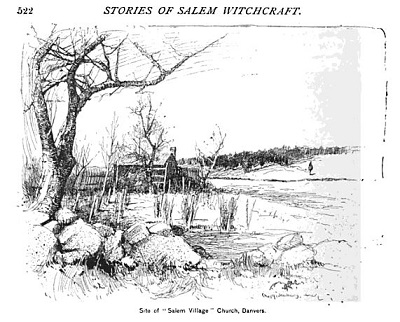
Site of Salem Village Church, Danvers, Mass, illustration published in the New England Magazine, Volume v, 1892
Even so, in examining the courtroom records, it appears that all of Samuel Parris' testimonies are but statements to the court that the afflicted girls appeared afflicted during the numerous examinations.
This is a fact because the girls did behave afflicted during the examinations. Whether they were merely pretending to be afflicted is unknown.
Parris never made any claims himself about seeing spectral visions or suffering fits or whatsoever other merits the other witnesses testified about.
According to Fowler, Parris was only nowadays in the courtroom at the request of the courtroom officials:
"Mr. Parris has oftentimes been defendant of being over officious, and a swift witness confronting the accused at the courts. Parris could not exist said to have been a chief witness in the prosecutions, although he may be said to accept been a frequent corroborating witness with his neighbors. The primary witnesses were the accusing girls, as they were called. At the preliminary examinations before the magistrates, Parris and others were required to exist present, when the depositions were taken down, as related past the girls, and subsequently made use of at the trials by the courts. These beingness given in and related past children, and young persons, the Courtroom required an endorsement from some older persons, who witnessed their supposed afflictions, and could attest to their depositions. It is in this way Mr. Parris' name, as well every bit his neighbors, ofttimes announced in the court documents. Parris appears to have been oftentimes at the examinations of those accused of witchcraft, and put questions to those on trial. He besides acted every bit a recorder to the magistrates more frequently than others. The reason for his existence often employed past the courts was but considering he was requested to do so, and was discovered to be well qualified for that purpose. We have seen the records of several persons thus employed, and should say Parris'south was the all-time. It was his do to accept down the examinations in curt hand, – he being a good stenographer, – and then write them out in full, in a plainly, legible hand."
Meanwhile, Parris also oversaw the excommunication of several bedevilled witches in his church building and fifty-fifty delivered the news to the victims themselves. Ane such victim was Martha Corey, whom Parris visited in prison house in September, co-ordinate to the church record book:
"11. September. Lords day
Sis Martha Corey taken into the Church. 27. April. 1690. was after Test upon suspicion of Witchcraft. 21. March. 1691-2 committed to Prison for that Fact, & was condemned to the Gallows for the same yesterday : And was this day in Publick by a full general consent voted to be excommunicated out of the Church; & Lft. Nathanael Putnam, & the 2 Deacons chosen to signify to her, with the Pastor the mind of the Church herein. Accordingly this 14. Septr. 1692. The 3. aforcsd Brethren went with the Pastor to her in Salem Prison, whom nosotros establish very obdurate justifying her self, & condemning all that had done any thing to her just discovery, or condemnation. Whereupon after a footling discourse (for her imperiousness would not suffer much) & after Prayer, (which she was willing to refuse) the dreadful judgement of Excommunication was pronounced against her."
Samuel Parris besides gave a sermon that day, which he titled "These Shall Make War with the Lamb" during which he stated that there were offending parties trying to make war with God. He defined these offending parties as antichrists and instruments of Satan who instigated the war past "sorceries and witchcrafts (plentiful amid the Papacy) doing lying wonders, whereby multitudes were deluded."
Parris also consoled his congregation by telling them that the war won't last forever for a number of reasons, i of them being: "Sometimes the devil loseth his volunteers in war. The lawful captive, the captives of the mighty, are sometimes delivered." He then went on to warn his parish that there were multitudes of witches in New England, including in the church building.
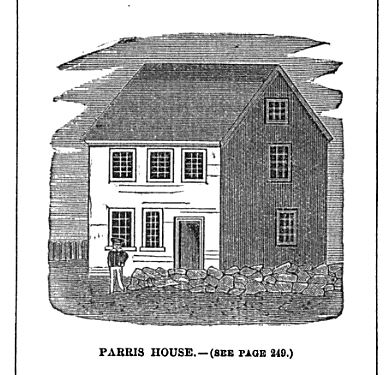
Parris House, illustration published in Old Naumkeag, circa 1877. This appears to actually be an illustration of the parsonage addition built in 1734.
Other sermons Samuel Parris gave that twelvemonth that take not been documented include a sermon given on May 8, 1692 which was based on the biblical text: 1 Corinthians ten:21: "Yet cannot beverage the cup of the lord and the cup of devils," a sermon on June 19, 1692 based on Canticles ii: 1 "I am the rose of Sharon, and the lily of the valleys" and a sermon on July 13, 1692 based on John vi:48 "I am the staff of life of life."
The last hangings of the Salem Witch Trials took place on September 22, 1692. Shortly afterwards, the court banned spectral bear witness, which made most of the witchcraft accusations groundless, and the witch trials began to die down. The last of the accused witches were released from prison in May of 1693.
Although Parris' slave Tituba had confessed and the jury declined to indict her, she remained in jail in Boston because Parris refused to pay her jail fees, which came to about £7.
Some historians think it's because Parris was angry at her for recanting her confession in prison. Others think he didn't want her in his dwelling house anymore because she should would take been a constant reminder of the witch trials.
Whatever the reason, in April of 1693, Tituba was sold to an unknown person for the cost of her jail fees. It is not known what happened to her hubby, John, at this point but it is causeless he was sold alongside Tituba considering Puritans were reluctant to carve up married slaves.
Samuel Parris After the Salem Witch Trials:
Samuel Parris' life immediately subsequently the Salem Witch Trials is a long, complicated mess of quarrels, lawsuits and counter lawsuits between him and his congregation in Salem.
From the church records, it appears that later the trials ended, the family members of those killed held Parris accountable for the Salem Witch Trials, according to Fowler:
"We accept not been able to discover the cause of the alleged complaint of witchcraft, against those three excellent women, viz: Rebecca Nurse, Mary Easty, and Sarah Cloyce. They were sisters, of a proficient education, and fair reputation. It is non to exist denied, that the part Parris took in the trials of these women, was the master cause of the opposition towards him, and led at last to his dismission from the people at the village. His master opposers were the relatives of these three unfortunate sisters. Samuel Nurse, a son of Rebecca Nurse, John Tarbell, who had married her girl, and Peter Cloyce, who had married Sarah Cloyce. These iii persons, together with i Thomas Williams, after the execution of Rebecca Nurse and Mary Easty, and the imprisonment of Sarah Cloyce, became much dissatisfied with Parris, and sought advice of the Elders in some of the neighboring churches, as to the best mode of bringing him before a council to reply for his conduct in the Witchcraft delusion."
These dissenters began protesting Parris past refusing to attend services. Parris filed a complaint against them for being absent from church. On February xvi, 1693 at a meeting of the church committee, the dissenters gave a list of reasons for their withdrawal, which states:
♦ they were unable to hear and empathize Parris' sermons over the "disturbing tumults and noise" fabricated in church by the afflicted girls
♦ they feared existence accused of witchcraft themselves
♦ Parris gave sermons on the witchcraft trials which they found offensive
♦ Parris held views on witchcraft that conflicted with that of the Orthodox Ministers
♦ Parris held an "easy and strong religion and belief" in the accusations made by the afflicted girls
♦ Parris displayed a lack of charity towards the accused
♦ Parris used "unwarrantable and ungrounded methods" of getting the affected girls to name suspected witches
♦ Parris provided testimony against the accused witches
♦ Parris served every bit a court stenographer during the witch trial examinations
♦ Parris preached unsafe and unChristian-like behavior
♦ Parris refused to explain his actions and his charge confronting them for withdrawing from church
This list was signed past John Tarbell, Thomas Wilkins and Samuel Nurse.
Afterward reading the charges against him, Parris wrote and presented a paper titled "Meditations for Peace" which is considered by many to be an acknowledgment of his errors during the trials.
In the paper, Parris admits to giving besides much weight to the spectral evidence provided past the afflicted girls and admits that "in that sore 60 minutes of distress and darkness" he may have spoken "unadvisedly." He asked for forgiveness and then they could all defeat the devil together.
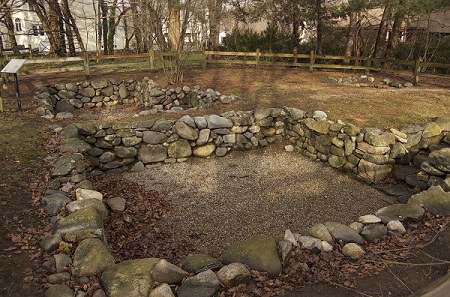
Foundation of the Salem Village Parsonage, Danvers, Mass
The paper didn't seem to help at all and the dissenters continued to effort and bring Parris before a church council.
Meanwhile, Parris repeatedly charged the dissenters with being absent from church and accused them with other "sundry objections" such as speaking and publishing libelous information against him and the church building, harassing him in church and at his home, refusing to contribute to his salary, urging other parishioners to join their cause and etc.
Afterward Parris read these objections aloud in church on November 13, 1693, the dissenters only scoffed and continued their cause.
After 2 years of quarreling, the church finally called a council on the matter at Salem Village on April 3, 1695. After hearing the case, the council, moderated past Increment Mather, simply recommended the dissenters to "consider whether, if they proceed to devour one some other, it will not be bitterness in the latter terminate."
The dissenters weren't satisfied with this response and instead signed another petition asking the council to rehear the case and motion Parris to another church.
Although Parris had his share of opposition in the church, the majority of his parishioners at the time actually wanted him to stay. The dissenters made this difficult for Parris though by persuading many parishioners not to pay their voluntary contributions to the church, which is what funded Parris' salary. From the yr 1694 until 1697, Parris only received a partial salary due to the quarrel.
On July 14, 1696, Parris suffered some other blow when his wife died. She was buried in the Wadsworth Burial Ground in Salem Village.
A few months later on, in October of 1696, it appears that Parris was finally dismissed from the parish because there are no more entries written in his handwriting in the church tape book afterward this appointment.
Although Parris had already been dismissed, on July 21, 1697, John Tarbell, Samuel Nurse, Joseph Putnam, Daniel Andrew renewed their charges against Parris, claiming he "did swear positively confronting the lives of such every bit he could non take whatsoever cognition just they might be innocent" and that he worked with the affected girls "to know who afflicted the people in their illnesses."
Co-ordinate to the book Salem Witch Trials: A Reference Guide the reason for the renewed charges is because the congregation was suing Parris for occupying the parsonage nine months afterward his dismissal. Parris responded by counter suing for his unpaid salary. The congregation lost their suit and, in 1697, paid Parris a settlement of £79 in back salary.
After Parris' dismissal from Salem Village he moved to Hold, Mass where he lived until 1705 and and then moved to Dunstable where he preached for half-dozen months in 1711. Parris then moved to Sudbury, Mass where his girl, Betty, lived until adulthood. Samuel Parris died in Sudbury on February 27, 1720.
Parris later made an appearance as a character in Arthur Miller'south 1953 play The Crucible. In the play he is portrayed as a power-hungry government minister who is determined to build up his position in the community but is disliked past many of the Salem residents.
The site of the Salem Hamlet Parsonage was excavated in 1970 and is open to visitors.
Rev. Samuel Parris Historical Sites:
Salem Village Parsonage Archaeological Site
Address: Rear 67 Centre Street, Danvers, Ma (site is attainable via a cart path)
Old site of the Salem Village Meetinghouse
Address: Near corner of Hobart and Woods Street, Danvers, Mass. Historical marking on site.
Sources:
Hanson, John Wesley. History of the Boondocks of Danvers, from its early settlement to the year 1848. John Wesley Hanson, 1848.
Stout, Harry Due south. The New England Soul: Preaching and Religious Culture in Colonial New England. Oxford University Press, 2011.
Salem-Village Witchcraft: A Documentary Record of Local Conflict in Colonial New England. Edited past Paul S. Boyer & Stephen Nissenabum. Northeastern University Press, 1993.
MacBean, Jenny. The Salem Witch Trials: A Master Source History of the Witchcraft Trials in Salem, Massachusetts. Rosen Publishing Grouping, Inc, 2003.
Fowler, Samuel Page. An Account of the Life, Graphic symbol, &c., of the Rev. Samuel Parris, of Salem Village. William Ives and George W. Pease, 1857.
Goss, K. David. The Salem Witch Trials: A Reference Guide. Greenwood Printing, 2007.
Starbuck, Anward. Cotton Mather's Relation to Salem Witchcraft. University of Chicago, 1922.
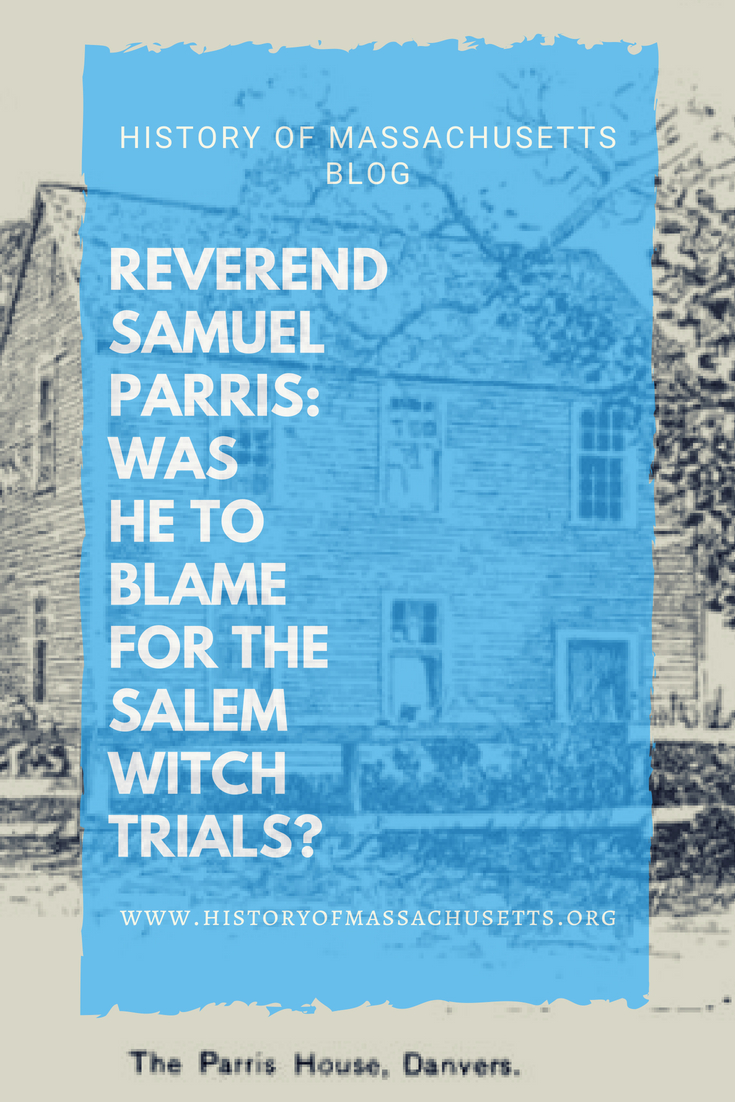
Source: https://historyofmassachusetts.org/reverend-samuel-parris/
0 Response to "Newpaper Article of the Conolly Family From Dunstable Mass That Was Killed in 1967"
Post a Comment